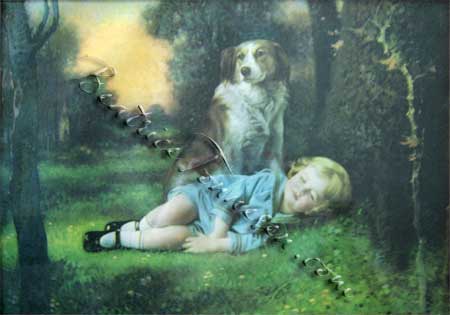 (Editor’s Note: 9/20/12: The publisher of a calendar featuring this print identified the artist as Alan Austin Pope, seeming to rule out the possibility that the A. Pope who painted from Tonnesen’s photos was Alexander pope, painter of dogs and wildlife.)
(Editor’s Note: 9/20/12: The publisher of a calendar featuring this print identified the artist as Alan Austin Pope, seeming to rule out the possibility that the A. Pope who painted from Tonnesen’s photos was Alexander pope, painter of dogs and wildlife.)
(Editor’s Note 2/13/08: Update- This print has been found with the signature “A. Pope.” Alexander Pope (1849-1924) was a well-known painter who specialized in dogs and wildlife. I am attempting to verify the signature. I will be posting another signed A. Pope print, which also started as a photo by Tonnesen, shortly.)
(Editor’s Note 5/26/2010: Update- A site visitor, Pat Johnson whose initial message appears at the bottom of this post, has kindly provided us with a copy of a letter written by Beatrice Tonnesen in 1954. Pat’s mother had written to Tonnesen regarding this print, which she owned. In her response, Tonnesen revealed that the child who posed for the photo was actually a girl! Tonnesen wrote: “…the child was a beautiful little girl…That child was not even asleep! Just posed for me completely relaxed. Quite remarkable for one so young.”)
As a collector of early twentieth century illustration art, I've wondered for years about the unsigned, untitled “mystery” print shown at top right. The sleeping boy and his trusty guard dog were popular subjects of a number of artists of the era. This little boy in his Edwardian outfit always looked to me like the child in RA Fox's “The Children's Hour,” done under his DeForest pseudonym. So I've always thought maybe this one, too, was by Fox.
And maybe Fox did paint the woodsy sunset and the flowered lawn, and the colorful details of the boy and dog. I don't know. (Although the flowers in the grass do look especially Foxy to me!) But the boy and dog definitely originated as a photo by Beatrice Tonnesen. Her original photo, shown bottom right, can be found in the Tonnesen Archive of the Oshkosh Public Museum. (Note the photo was taken inside with a crude prop under the boy's head, as though it was planned that another background would be added later.) Fox is reported to have shared Tonnesen's studio for a time during the ‘20's, and is known to have painted on occasion from Tonnesen's photos.
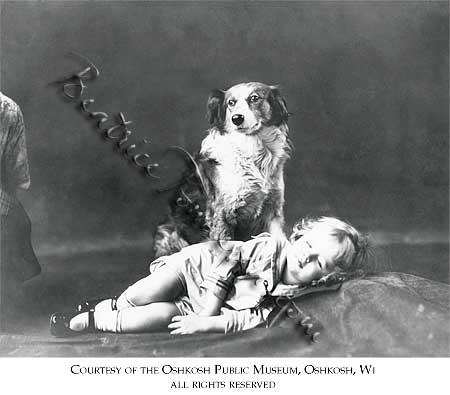 Tonnesen herself was an accomplished painter, and it is possible that she was both the photographer and the artist. My theory, however, is that when she alone was responsible for both the photography and the painting of a work, she signed it. More often, it appears, she sold her photographs to artists and publishers for their use, to embellish as they desired, without crediting the photographer. So I think this beautiful print was finished by some other artist – maybe R Atkinson Fox or, possibly, a talented staff artist employed by the publisher. What do you think? Regardless of the artist's identity, I'm happy that we can now credit Tonnesen with the creation of the appealing photographic image that is central to the work.
Tonnesen herself was an accomplished painter, and it is possible that she was both the photographer and the artist. My theory, however, is that when she alone was responsible for both the photography and the painting of a work, she signed it. More often, it appears, she sold her photographs to artists and publishers for their use, to embellish as they desired, without crediting the photographer. So I think this beautiful print was finished by some other artist – maybe R Atkinson Fox or, possibly, a talented staff artist employed by the publisher. What do you think? Regardless of the artist's identity, I'm happy that we can now credit Tonnesen with the creation of the appealing photographic image that is central to the work.
(For more information on R Atkinson Fox and other early twentieth century illustrators, visit the RA Fox Society.)
All Content Copyright 2007 Lois Emerson
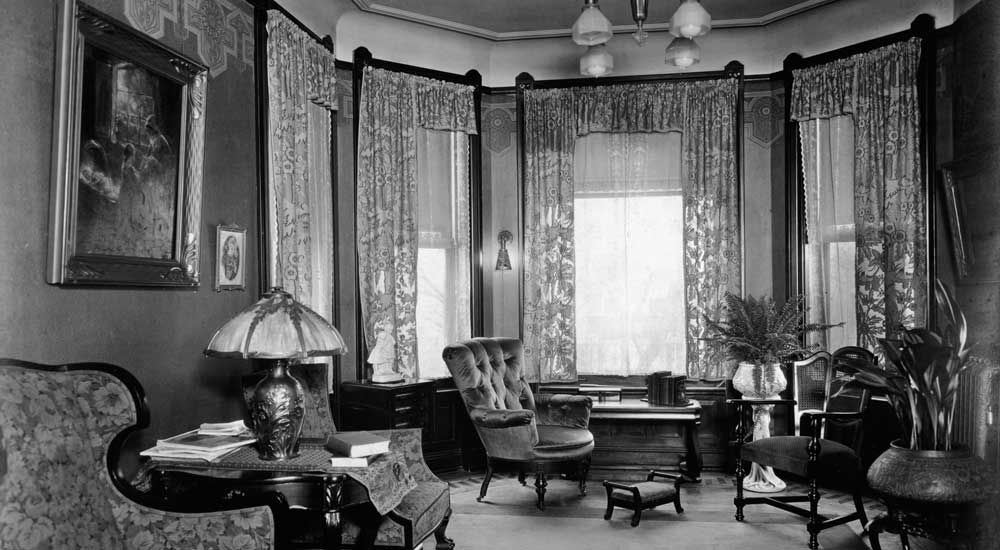

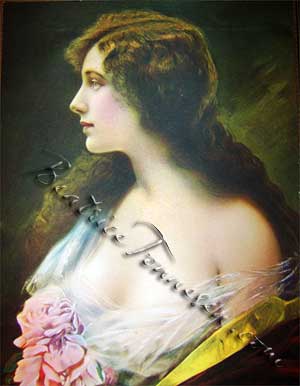 1. The images contain props and/or costumes known to have been used by the Tonnesen Studio. Once an item appears in a signed Tonnesen print, its presence in an unsigned print suggests the same point of origin. For example, the fancy footstool shown in
1. The images contain props and/or costumes known to have been used by the Tonnesen Studio. Once an item appears in a signed Tonnesen print, its presence in an unsigned print suggests the same point of origin. For example, the fancy footstool shown in 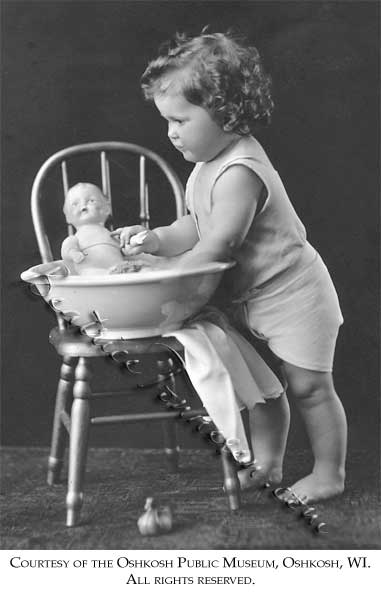
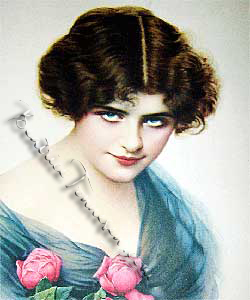 Beatrice Tonnesen has not generally been recognized as a major contributor to the so-called “Golden Age of Illustration,” that period in America from about 1900-1940, when calendar art was intensely popular. Artists such as the Hintermeisters, R. Atkinson Fox, Gene Pressler, Zula Kenyon, Arthur Elsley and others carved out lucrative careers by providing the publishers and calendar companies with appealing artwork for mass consumption.
Beatrice Tonnesen has not generally been recognized as a major contributor to the so-called “Golden Age of Illustration,” that period in America from about 1900-1940, when calendar art was intensely popular. Artists such as the Hintermeisters, R. Atkinson Fox, Gene Pressler, Zula Kenyon, Arthur Elsley and others carved out lucrative careers by providing the publishers and calendar companies with appealing artwork for mass consumption. 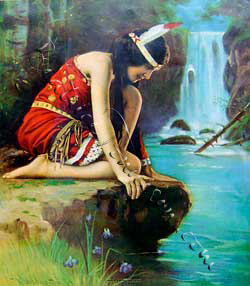 That’s because a signed Tonnesen is a relative rarity. Beatrice Tonnesen, a phenomenally successful Chicago-based photographer, was also the artistic genius behind many of the art prints that graced calendars, picture frames and magazine and newspaper ads from the turn of the last century through 1930, and beyond. Most often, it appears, her photos were unsigned and unattributed, purchased by publishers or advertisers, tinted or otherwise enhanced, and copyrighted by them for their own use. A few were signed by Tonnesen and published on her own or by others. In many of those, Tonnesen appears to have painted from her own photographs. Most surprisingly, however, some of her photographs appear to have formed the basis for art prints, painted and signed by other artists of the day.
That’s because a signed Tonnesen is a relative rarity. Beatrice Tonnesen, a phenomenally successful Chicago-based photographer, was also the artistic genius behind many of the art prints that graced calendars, picture frames and magazine and newspaper ads from the turn of the last century through 1930, and beyond. Most often, it appears, her photos were unsigned and unattributed, purchased by publishers or advertisers, tinted or otherwise enhanced, and copyrighted by them for their own use. A few were signed by Tonnesen and published on her own or by others. In many of those, Tonnesen appears to have painted from her own photographs. Most surprisingly, however, some of her photographs appear to have formed the basis for art prints, painted and signed by other artists of the day.